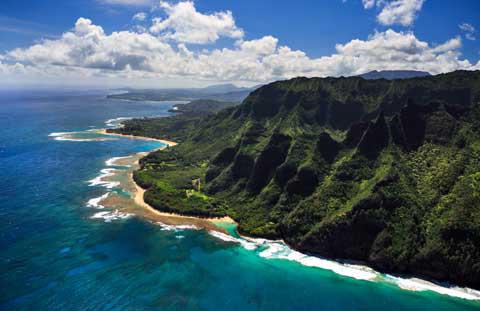Traveling in Hawaii
 Kauai Coastline, Hawaii
Kauai Coastline, Hawaii
Located towards the center of the Pacific Ocean and the northeast corner of Polynesia, Hawai'i is the 50th state of the United States of America. It is a major tourist destination for travelers from around the world and as such, its economy is very dependent on the tourist dollar. Historically, the state had strong whaling, sugar and pineapple industries, but today tourism and the military make up a significant part of the economy. The state includes many islands that spread over 1,500 miles, but there are eight main islands which have a diversity of natural beauty and interesting landscapes. The islands offer visitors many impressive features from the beautiful beaches to the lush interior. There is a lot of hiking, snorkeling and scuba diving available throughout the islands. The capital of the state is Honolulu, which is also the largest city. Both Hawaiian and English are spoken throughout.
Hawaii's climate is similar to what you would find throughout the tropics. There are almost constant trade winds from the east that do keep the temperatures and humidity milder. Summer highs are around 88 degrees Fahrenheit and winter highs are around 83 degrees Fahrenheit. You might find snow at elevations above 13,800 feet on Mauna Kea and Mauna Loa on the "The Big Island".
Regions
Hawaii is an archipelago that has many distinct volcanic islands, but there are eight major islands with six open to tourists. These six are Hawaii (The Big Island), Oahu, Maui, Kauai, Molokai, and Lanai. Niihau and Kahoolawe are the remaining two islands, the former of which is privately owned and limited to Native Hawaiians and the latter is a former U.S. Navy bombing range.

 Budget Your Trip is all about finding out how much everything costs so that you can travel cheaper and longer. Created by avid travelers Laurie and Bryan, our goal is to help you plan your next trip on the right budget. With average daily travel costs that are calculated from the budgets of real travelers, plus an analysis of hotel and tour prices, you can find out how much money you need to plan your next adventure. We also have plenty of travel advice, accommodation reviews, and activity suggestions.
Budget Your Trip is all about finding out how much everything costs so that you can travel cheaper and longer. Created by avid travelers Laurie and Bryan, our goal is to help you plan your next trip on the right budget. With average daily travel costs that are calculated from the budgets of real travelers, plus an analysis of hotel and tour prices, you can find out how much money you need to plan your next adventure. We also have plenty of travel advice, accommodation reviews, and activity suggestions.
I think what makes Hawaii particularly expensive is that you really need to have a car to explore any of the islands in depth, and rental cars can be expensive.